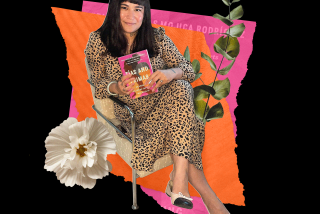Latina’s Young Founder Takes Aim at Women Just Like Her
NEW YORK — After a string of successful sales calls with America’s major auto makers, Christy Haubegger was flying high. Still clad in her gray pinstriped suit and high-heeled shoes, she bounded down the hallway of her hotel.
Looking forward to a cool drink and a warm bath, Haubegger recounted, she filled her ice bucket and headed back to her room. An older couple spotted her, and asked, “Dear, will you be bringing ice to all the rooms?”
Haubegger, the founder and publisher of Latina magazine, had been mistaken for a maid. Her perfect day last spring ended with the thought that even in her business attire, a stranger saw her youthful face, tiny frame and brown skin and assumed she was an employee, not a guest, at the $150-a-night Detroit hotel.
A desire to change perceptions like those helped motivate Haubegger to launch Latina in June 1996. The magazine shares newsstand space with a growing number of publications targeting the Spanish-speaking market, but it is the only truly bilingual book, with stories in English, shorter summaries in Spanish and Spanish slang interspersed throughout.
Haubegger, 30, is a natural leader for the magazine. Born to a Mexican woman, she was adopted by a white family in Houston. Her adoptive parents enrolled her in a bilingual preschool and taught her about her heritage, and she grew up feeling comfortable in both cultures.
Like many young girls, she developed a fondness for teen magazines, perusing them for tips on makeup, hairstyles and dating. It didn’t escape her notice, though, that most of the girls pictured in the magazines were tall, lean, blond and blue-eyed.
“I never saw anyone who looked like me,” she said.
After studying philosophy at the University of Texas, Haubegger headed to Stanford University for law school. For a business law class, she was assigned to create a business plan, and drew up a prototype of a magazine.
Her plan was not entirely different than the magazines she loved as a teenager. There were fashion and beauty tips and celebrity stories. But in her dream magazine, the makeup would flatter olive complexions. The models would be more voluptuous than the slender waifs in most women’s magazines. Personality profiles would showcase strong, successful Latina women.
It was Latina. The professor liked the plan and told Haubegger the magazine seemed viable, but she shrugged off the suggestion.
“I still thought I’d become a lawyer,” she said. But when she graduated in 1992, she began to doubt her passion for a legal career, and resurrected her business plan.
Using the demographic data and editorial plan she’d created for her class, she began asking professors, business contacts, family members and venture capitalists to put up money for the magazine. She eventually drummed up about $250,000, enough to create a prototype and form her own company, Alegre Enterprises. She then began seeking a business partner.
After calling on everyone she knew with ties to publishing, Haubegger met Edward Lewis, the founder of Essence magazine, at a party. He agreed to meet with her in San Francisco, where she clinched his support by taking him through the Mission district, a largely Latino neighborhood where she then lived.
She pointed out Latin women toting copies of magazines like Glamour and Cosmopolitan, and told Lewis, “They need their own.” Lewis agreed, and formed a joint venture with Alegre and his company, Essence Communications.
Haubegger began shopping the magazine around to potential advertisers. From a purely demographic standpoint, Latina wasn’t a tough sell.
Latinos make up 11% of the U.S. population--about 30 million people--and are expected to be the nation’s largest minority group by 2005. Their disposable income is estimated at $348 billion a year, an increase of 66% since 1990.
But many advertisers feared Latinos didn’t read as much as whites or blacks, and they weren’t familiar with Latino shopping habits.
“If you are selling ads for Glamour or Cosmo, you don’t have to explain who your clients are,” Haubegger said. “We go in, and we have to convince the company, ‘I am just like you. My last name happens to be Garcia, but I brush my teeth, and I wear perfume, and I buy clothes and cars.’ ”
In 1998, Latina guaranteed advertisers it would sell 175,000 copies a month; this year, that rate base increases to 200,000. Haubegger dreams of the 1-million mark, although she knows Latina will face a growing number of competitors in the next few years.
But as she works away at next month’s issue, she still relishes the thrill of seeing Latina on a New York City newsstand for the first time.
“Jennifer Lopez was on the cover,” she said. “The magazine right next to it had Claudia Schiffer. And we looked just as good.”
More to Read
Sign up for our Book Club newsletter
Get the latest news, events and more from the Los Angeles Times Book Club, and help us get L.A. reading and talking.
You may occasionally receive promotional content from the Los Angeles Times.






